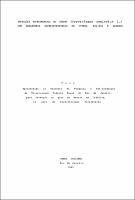| ???jsp.display-item.social.title??? |


|
Please use this identifier to cite or link to this item:
https://tede.ufrrj.br/jspui/handle/jspui/3799| ???metadata.dc.type???: | Dissertação |
| Title: | Infecções experimentais no coelho (Oryctolagus cuniculus L.) com nematodeos gastrintestinais de ovinos, bovinos e equinos |
| Other Titles: | ... |
| ???metadata.dc.creator???: | Coutinho, Vanda  |
| ???metadata.dc.contributor.advisor1???: | Honer, Michael Robin |
| ???metadata.dc.contributor.referee1???: | Honer, Michael Robin |
| ???metadata.dc.contributor.referee2???: | Lopes, Carlos Wilson Gomes |
| ???metadata.dc.contributor.referee3???: | Brito, Deoclécio Bezerra |
| ???metadata.dc.description.resumo???: | O experimento foi realizado visando avaliar a atuação do coelho em infecções experimentais com larvas de nematódeos gastrintestinais de ovinos, bovinos e eqüinos, bem como estudar as alterações patólogicas determinadas. Para o trabalho, foram utilizados 30 coelhos sem raça definida, jovens e adultos, sendo 16 machos e 14 fêmeas, mantidos na Estação para pesquisa parasitológica W. O. Neitz. da área de Parasitologia, Instituto de Biologia da Universidade Federal Rural do Rio de Janeiro, Itaguaí, Estado do Rio de Janeiro. Dois coelhos foram usados como controles e 28 inoculados. Destes, nove foram reinoculados, utilizando-se para ambos os tratamentos um total de 907.000 larvas. No decorrer do experimento, os animais foram sacrificados em diferentes intervalos de tempo, encontrando-se 21 positivos correspondendo a 75% e 7 foram considerados negativos com percentual de 25%. 60 Os nematódeos obtidos no experimento foram T. colubriformis, T. axei e C. punctata, perfazendo um total de 11.091 exemplares adultos que corresponderam a 1,223% das larvas ino- -3 caladas e 60 imaturos dando 6,6 x 10 % do inóculo; 43,48% dos helmintos eram machos e 56,52% fêmeas. Os períodos prepatentes observados foram em torno de 12 a 21 dias para T. colubriformis procedentes de ovinos e 20 a 29 dias para T. colubriformis de origem bovina. Não houve eliminação de ovos de C. punctata e T. axei. Não ocorreram sintomas graves e mortes em conseqüecia do experimento e as variações de peso e temperatura foram discretas. As alterações macroscópicas foram hemorragias petequiais no intestino delgado e nos exames histopatológicos desse órgão, as alterações foram mais acentuadas nos coelhos reinfectados, observando-se principalmente atrofia de vilosidades naqueles inoculados com larvas de nematódeos de ovinos e coelhos, hiperplasia celular nos inoculados com larvas de nematódeos de bovinos e erosões das vilosidades nos inoculados com larvas de nematódeos de eqüinos. |
| Abstract: | The present study was carried out to evaluate the actuation of the rabbit (Oryctolagus cuniculus L.) as a host for experimental infections with gastrointestinal nematodes of sheep, cattle and horses, as well as the pathological lesions caused by these infections. Thirty rabbits of mixed breed were used, of various ages, 16 males and 14 females kept of the Experimental Station W. O. Neitz, of the Parasitology department, Biology Institute, of the Federal Rural University of Rio de Janeiro, Itaguaí, Rio de Janeiro State. Two rabbits were maintained as controls and 28 were inoculated; of these 9 were re-inoculated. In total, including all treatments, 907,000 infective larvae were used. During the experiment, the animals were sacrificed at different periods, when 21 were found to be positive (75%) and 7 were considered to be negative (25%). 62 The species of nematodes obtained in this experiment were Trichostrongylus colubriformis, T.axei and Cooperia punctata, with a total of 11,091 specimens as adults, corresponding to 1.223% of the infective larvae used, -3 as well as 60 inmatures, the equivalent of 6.0 x 10 % of the larvae used. Of the adult nematodes, 43.48% were males and 56.52% were females. Prepatent periods were between 12 to 21 days for T. colubriformis inoculated from sheep and 20 to 29 days for those inoculated from cattle: no eggs were produced by T. axei or c. punctata. No deaths or severe symptoms were seen as a result of the inoculations of infective larvae; variations in temperature and weight were slight. The macroscopic alterations seen were petechial haemorrhages in the small intestine and histopathological examination of this organ showed that alterations were most marked in those rabbits which had been re-inoculated. Principally, atrophy of the villi was seen in those animals inoculated with larvae from sheep and passaged in rabbits; cellular hyperplasia was seen in those animals inoculated with larvae from cattle and erosion of the villi in those rabbits inoculated with infective larvae obtained from horses. |
| Keywords: | Helmintologia |
| ???metadata.dc.subject.cnpq???: | Medicina Veterinária |
| Language: | por |
| ???metadata.dc.publisher.country???: | Brasil |
| Publisher: | Universidade Federal Rural do Rio de Janeiro |
| ???metadata.dc.publisher.initials???: | UFRRJ |
| ???metadata.dc.publisher.department???: | Instituto de Veterinária |
| ???metadata.dc.publisher.program???: | Programa de Pós-Graduação em Ciências Veterinárias |
| Citation: | Coutinho, Vanda. Infecções experimentais no coelho (Oryctolagus cuniculus L.) com nematodeos gastrintestinais de ovinos, bovinos e equinos. 1983. 70 f. Dissertação (Programa de Pós-Graduação em Ciências Veterinárias) - Universidade Federal Rural do Rio de Janeiro, Seropédica-RJ. |
| ???metadata.dc.rights???: | Acesso Aberto |
| URI: | https://tede.ufrrj.br/jspui/handle/jspui/3799 |
| Issue Date: | 26-Aug-1983 |
| Appears in Collections: | Mestrado em Ciências Veterinárias |
Files in This Item:
| File | Description | Size | Format | |
|---|---|---|---|---|
| 1983 - Vanda Coutinho.pdf | Vanda Coutinho | 648.23 kB | Adobe PDF |  Download/Open Preview |
Items in DSpace are protected by copyright, with all rights reserved, unless otherwise indicated.




